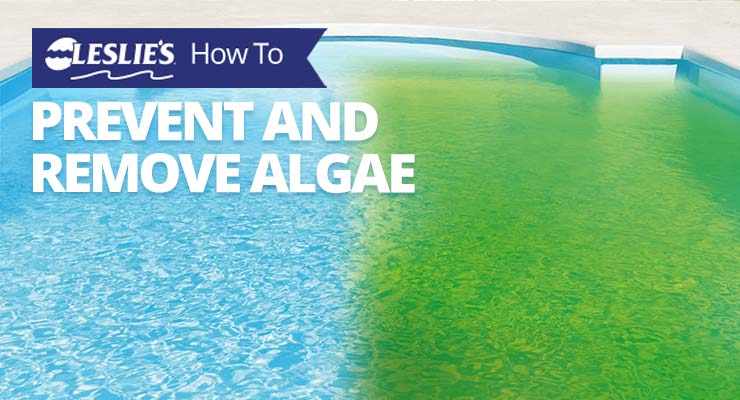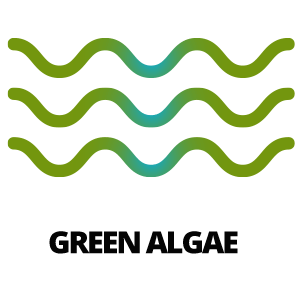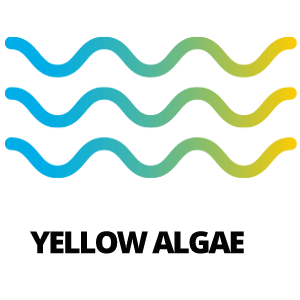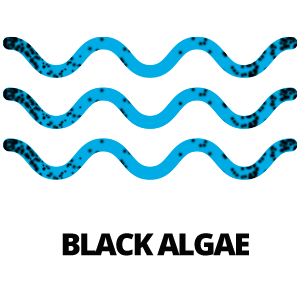
How to Prevent and Remove Algae
Nowadays, it’s popular to “go green.” While we're all for environmental awareness, green isn't great when it comes to the color of your pool. If your pool goes green, you have an algae problem.
Algae spores enter pool water from wind and storms. When conditions are right and your water isn’t properly balanced, you’ll find yourself in the middle of an algae bloom. Not only is it an eyesore, it can cause damage to pool surfaces and harbor disease-causing microorganisms. There are three types of algae commonly found in swimming pools:



Green algae is the most common, and it’s the easiest to kill. Yellow algae, also known as Mustard algae, is often mistaken for dirt or sand at the bottom of the pool, but it can also grow on pool walls. Black algae is the least common, but is also the hardest to remove; it looks like small spots, but it has roots that penetrate deep into the surface of plaster, quartz, or pebble surface pools. Black algae can also attach to tile grout.
If you have algae, you need to act quickly to remove it. Let's dive in to some algae prevention measures, and we’ll also walk you through how to remove algae from your pool.
Algae Treatment and Prevention Supplies
Whether you’re preventing growth or treating an algae outbreak in your pool, there are a few essential tools and chemicals you’ll need.
- Water test kit or strips
- Algaecide
- Chlorine pool shock
- Water clarifier
- Phosphate remover
- Pool brush
- Algae prevention products (chlorine tabs, shock, Perfect Weekly)
How to Prevent Pool Algae
To keep algae from taking over your pool, there are a few things you can do as part of your regular maintenance routine.
- Keep Free Available Chlorine (FAC) levels between 2.0 and 4.0 ppm, and maintain proper water balance.
- Shock your pool once a week.
- Brush the entire pool at least once a week.
- Run your filter pump at least one hour per every 10°F of air temperature. Variable speed pumps should run longer based on the speed.
- Phosphates are algae food; keep phosphate levels below 100 ppb.
DIY TIP: Use a phosphate remover during your weekly water care routine. There are many products available, including Leslie’s noPHOS, Leslie’s Perfect Weekly, and Natural Chemistry PHOSfree.
How to Remove Pool Algae
Even the most well-maintained pools can succumb to algae if the conditions are right. Before getting started, it’s important to identify which type of algae you’re dealing with. If you’re not sure, you can always take a water sample to your local Leslie’s store for a complete diagnosis. To remove green or yellow algae from your pool, follow these steps:
- Clean or backwash your filter.
- Turn on the pump and let it run for at least 36-48 hours during algae treatment.
- Adjust water chemistry before adding algae removal products.
- Adjust the pH to 7.8 or higher
- Adjust the Total Alkalinity to 80-120 ppm depending upon the type of primary sanitizer used. (80-100 ppm for sodium hypochlorite, calcium hypochlorite or lithium hypochlorite; and 100-120 ppm for dichlor, trichlor and bromine tablets.)
- Adjust the Cyanuric Acid level to 25-75 ppm
- Adjust the Free Available Chlorine level to 2.0-2.5 ppm
- Thoroughly brush all pool surfaces, including the steps, walls, and floor. When finished, leave the brush attachment on the first step while you complete the algae treatment. This will remove the algae from your cleaning attachment, as well.
- Treat your pool with the correct algaecide (Leslie's Green to Clean or Yellow Out) required to treat your algae type. Read and follow all label instructions for dosage and application. Add half of the prescribed amount of product around the perimeter of the pool, starting where the algae is thickest, then add the remaining half over the problem areas. Wait five minutes before proceeding to the next step.
- Shock the pool with calcium hypochlorite shock, such as Leslie’s Power Powder Plus 73. Use two pounds of shock for every 15,000 gallons of water, and shock your pool three times, waiting 12 hours between each round of shock. Remember to always read and follow the label directions when adding any pool chemical.
- Wait 12 hours after the final shock application before turning off your pool pump. Now is the best time to check your pool’s phosphate level. If phosphates are above 300 ppb, use a phosphate reducer to bring the level down below 100 ppb.
- Backwash or clean your filter, then turn the pump back on and resume regular run time.
- Once sanitizer levels are below 5 ppm, add a clarifier such as Leslie's offers Leslie's Clear Aid to remove the dead algae.
Removing algae from the pool can be a costly and time-consuming process. It’s important to keep up with the weekly preventive measures to keep the green out of your pool and save some “green” in your pocket. If you need help testing your water or would like more information about algae, stop by your local Leslie’s store for personalized service, a free AccuBlue® water test, and a free brochure on algae removal.